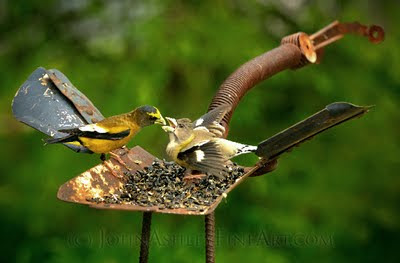 |
| An adult male Black-capped Chickadee (left) feeds juicy spiders to his adult female mate after nest-building but prior to egg-laying. |
Today we will lavish the motherly ladies in our lives with gifts of food and flowers. Mother's Day was officially recognized in 1914 by President Woodrow Wilson, more than 40 years after Julia Ward Howe (who penned "The Battle Hymn of the Republic") began promoting the idea. Earlier, this idea had been dropped by English settlers to the U.S., even though an English clerical decree in the 1600's officially widened the "Mothering Day" celebration to include real mothers. Prior to the decree, Europeans celebrated Mothering Day to honor the "Mother Church." Earlier still, the ancient Greeks honored the goddess Rhea (mother of most major deities) and, before that, the ancient Egyptians honored the goddess Isis (mother of the pharaohs).
But long before all of these people, there were those male Chickadees feeding spiders to their egg-laying mates.
Many mammals and insects use mate-feeding strategies as well, but let's stick to birds for the sake of simplicity. Among bird species, males may place food directly into the mouth of a begging female (she is imitating the behavior of a hungry chick), or he may hold the food in his beak and present it to his mate, or he may regurgitate food on the ground in front of his mate (just as he will do for their chicks).
But why mate-feed? What benefits could the male and/or female gain that would drive the natural selection of this behavior? As you probably guessed, there are multiple theories.
MATE-FEED TO FORM OR STRENGTHEN THE PAIR BOND
 |
| An adult male Evening Grosbeak (left) feeds his adult mate the sunflower seeds that she's standing on. Her behavior imitates hungry, begging chicks. |
However, in Kittiwakes, a male's mate-feeding rate was correlated to his ability to re-pair with the same female in the following nesting season. So if he impresses her this year, it can strengthen their pair bond for next year.
MATE-FEED IN EXCHANGE FOR COPULATION
Again, Kestrels copulated many weeks before the males began to feed their mates. And in an Osprey study, only about 16% of copulations were associated with mate-feeding behavior. So this theory appears to be, well, limp.
MATE-FEED TO IMPROVE THE FEMALE'S BODY CONDITION
Mate-feeding rates were closely tied to female body mass (weight) in many species, including Flycatchers, Kestrels, Osprey and Wrens. Female Kestrel weights rose when mate-feeding started and peaked at egg-laying (males lost weight). Compared to females with lower rates of mate-feeding, well-fed female birds tended to lay larger clutches of heavier eggs, have shorter incubation periods, produce heavier chicks, and have higher rates of young survival. Even the start of egg-laying appeared to be directly related to the start of mate-feeding. So it looks like many birds use mate-feeding to bulk up the female and prepare her for the caloric demands of egg-laying and incubation.
Finally, a theory that seems to fit!
MATE-FEED TO ALLOW FEMALE TO ASSESS THE MALE'S PARENTAL CARE ABILITY
 |
| Adult male Mountain Chickadee (left) feeds spiders to one of his chicks that fledged the nest 20 minutes earlier. His behavior is a repeat of mate-feeding. |
MATE-FEED AS AN ADAPTATION TO THE RISK OF NEST PREDATION
But one of the most highly-finessed bird behaviors may be the rate of mate-feeding in relation to the risk of nest predation. More male trips to the nest means more chances for a predator to find the nest. In the cavity-nester/open-nester study, mate-feeding rates at both nest types were lower where there were fewer nest predators present, and higher where there were relatively more nest predators. In another study, the rate of mate-feeding increased after potential nest predators were artificially removed. In other words, the male birds could adjust their mate-feeding rates based on their perceived risk of nest predation.
When more predators are detected by the male, he makes fewer trips to the nest, and female fitness decreases. When the male perceives relatively fewer nest predators, he increases his mate-feeding rates, and female fitness increases. You can easily see how this (predator detection) would drive the natural selection of the male's behavior (mate-feeding), in conjunction with improving the female's weight.
SUMMARY
So why mate-feed? By looking at different bird species in different conditions, we start to see that the answer can be a combination of strategies that are adjustable based on what is happening around the nesting birds. In other words, it's complicated.
So take your mom out to brunch today. And make dinner for your wife tonight -- if she asks what you are doing, just tell her that, "It's complicated." Even those of us that can't really cook all that well can rest assured that this gift to our mates will taste better than a mouth full of spiders.

